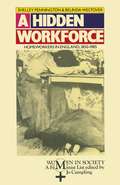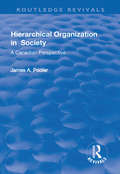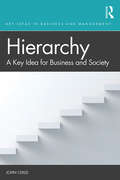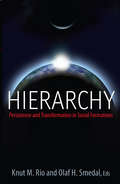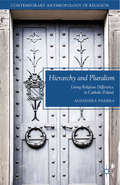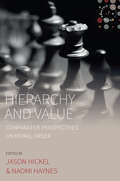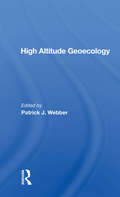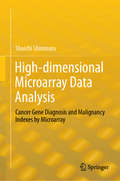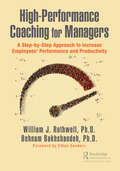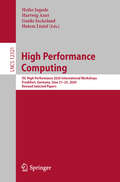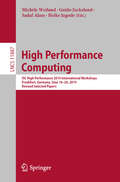- Table View
- List View
Hidden Voices: Lived Experiences in the Irish Welfare Space (Key Issues in Social Justice)
by Joe WhelanUnderpinned by the idea of the right to a ‘basic minimum’, welfare states are a major feature of many societies. However, the lived experiences of persons seeking and receiving welfare payments can often be overlooked. This book seeks to remedy this omission by honouring lived experience as valuable, insightful and necessary. It draws on qualitative interviews with 19 people receiving various working age welfare payments in Ireland to explore stigma, social reciprocity and the notions of the deserving and undeserving poor, and to analyse welfare conditionality in the Irish context. Breaking new ground, this book offers original research findings which contest and inform policy both within Ireland and beyond.
Hidden Voices: Lived Experiences in the Irish Welfare Space (Key Issues in Social Justice)
by Joe WhelanUnderpinned by the idea of the right to a ‘basic minimum’, welfare states are a major feature of many societies. However, the lived experiences of persons seeking and receiving welfare payments can often be overlooked. This book seeks to remedy this omission by honouring lived experience as valuable, insightful and necessary. It draws on qualitative interviews with 19 people receiving various working age welfare payments in Ireland to explore stigma, social reciprocity and the notions of the deserving and undeserving poor, and to analyse welfare conditionality in the Irish context. Breaking new ground, this book offers original research findings which contest and inform policy both within Ireland and beyond.
A Hidden Workforce: Women Homeworkers in Britain, 1850-1985 (Women in Society)
by Shelley Pennington Belinda WestoverA study of women homeworkers in the context of the changing status of women from 1850 to 1985, this examines the changes in the homework labour force, and the alternatives open to women. The authors critically evaluate attempts to improve the position of homeworkers and comment on future prospects.
HIDING POLITICS C: Cause Marketing, Corporate Influence, and Breast Cancer Policymaking
by Patricia StrachAs late as the 1980s, breast cancer was a stigmatized disease, so much so that local reporters avoided using the word "breast" in their stories and early breast cancer organizations steered clear of it in their names. But activists with business backgrounds began to partner with corporations for sponsored runs and cause-marketing products, from which a portion of the proceeds would benefit breast cancer research. Branding breast cancer as "pink"--hopeful, positive, uncontroversial--on the products Americans see every day, these activists and corporations generated a pervasive understanding of breast cancer that is widely shared by the public and embraced by policymakers. Clearly, they have been successful: today, more Americans know that the pink ribbon is the symbol of breast cancer than know the name of the vice president. Hiding Politics in Plain Sight examines the costs of employing market mechanisms--especially cause marketing--as a strategy for change. Patricia Strach suggests that market mechanisms do more than raise awareness of issues or money to support charities: they also affect politics. She shows that market mechanisms, like corporate-sponsored walks or cause-marketing, shift issue definition away from the contentious processes in the political sphere to the market, where advertising campaigns portray complex issues along a single dimension with a simple solution: breast cancer research will find a cure and Americans can participate easily by purchasing specially-marked products. This market competition privileges even more specialized actors with connections to business. As well, cooperative market activism fundamentally alters the public sphere by importing processes, values, and biases of market-based action into politics. Market activism does not just bring social concerns into market transactions, it also brings market biases into public policymaking, which is inherently undemocratic. As a result, industry and key activists work cooperatively rather than contentiously, and they define issues as consensual rather than controversial, essentially hiding politics in plain sight.
Hiding Politics in Plain Sight: Cause Marketing, Corporate Influence, and Breast Cancer Policymaking
by Patricia StrachAs late as the 1980s, breast cancer was a stigmatized disease, so much so that local reporters avoided using the word "breast" in their stories and early breast cancer organizations steered clear of it in their names. But activists with business backgrounds began to partner with corporations for sponsored runs and cause-marketing products, from which a portion of the proceeds would benefit breast cancer research. Branding breast cancer as "pink"--hopeful, positive, uncontroversial--on the products Americans see every day, these activists and corporations generated a pervasive understanding of breast cancer that is widely shared by the public and embraced by policymakers. Clearly, they have been successful: today, more Americans know that the pink ribbon is the symbol of breast cancer than know the name of the vice president. Hiding Politics in Plain Sight examines the costs of employing market mechanisms--especially cause marketing--as a strategy for change. Patricia Strach suggests that market mechanisms do more than raise awareness of issues or money to support charities: they also affect politics. She shows that market mechanisms, like corporate-sponsored walks or cause-marketing, shift issue definition away from the contentious processes in the political sphere to the market, where advertising campaigns portray complex issues along a single dimension with a simple solution: breast cancer research will find a cure and Americans can participate easily by purchasing specially-marked products. This market competition privileges even more specialized actors with connections to business. As well, cooperative market activism fundamentally alters the public sphere by importing processes, values, and biases of market-based action into politics. Market activism does not just bring social concerns into market transactions, it also brings market biases into public policymaking, which is inherently undemocratic. As a result, industry and key activists work cooperatively rather than contentiously, and they define issues as consensual rather than controversial, essentially hiding politics in plain sight.
Hierarchical Organization in Society
by James A PoolerThis title was first publiished in 2000: A hierarchy is an organization system that is structured in a treelike manner, with levels of status or authority stacked one above the other. The classical and best known example of a hierarchy is probably the typical diagram that describes the structure of a company or business, also known as the corporate ladder. This text argues that hierarchies are one of the most important concepts we have in order to understand the world around us, and looks at hierarchies in a wide variety of areas of interest to everybody, such as companies, educational systems, transport systems, retail stores, corporations, communities, population migrations, medical systems, and many other real-world phenomena. From a Canadian perspective, the text examines these hierarchies and their effects at a variety of scales. It discusses how to understand the system around us and the ones in which we are immersed every day. The central theme is that it is possible to get a better grip on the past, present and future of the world, if it is viewed through an understanding of hierarchies.
Hierarchical Organization in Society
by James A PoolerThis title was first publiished in 2000: A hierarchy is an organization system that is structured in a treelike manner, with levels of status or authority stacked one above the other. The classical and best known example of a hierarchy is probably the typical diagram that describes the structure of a company or business, also known as the corporate ladder. This text argues that hierarchies are one of the most important concepts we have in order to understand the world around us, and looks at hierarchies in a wide variety of areas of interest to everybody, such as companies, educational systems, transport systems, retail stores, corporations, communities, population migrations, medical systems, and many other real-world phenomena. From a Canadian perspective, the text examines these hierarchies and their effects at a variety of scales. It discusses how to understand the system around us and the ones in which we are immersed every day. The central theme is that it is possible to get a better grip on the past, present and future of the world, if it is viewed through an understanding of hierarchies.
Hierarchie als Chance: Für erfolgreiche Kommunikation und Kooperation in Team und Organisation
by Herbert HappelIn diesem Buch geht es um das richtige Verständnis von Hierarchie in der beruflichen Arbeit. Egal ob Mitarbeiter, Kollege oder Chef: Für alle kann Hierarchie ein natürliches und nutzbares Prinzip ihrer Zusammenarbeit werden. Ihre Verantwortungs- und Machtstrukturen beflügeln oder bremsen. Das Geheimnis liegt in der passenden Dosierung und sachdienlichen Ausgestaltung. Das Buch will ermutigen, die Prämissen der Organisation ernst zu nehmen und anleiten, Hierarchie funktional und partizipativ zu nutzen.
Hierarchy: A Key Idea for Business and Society (Key Ideas in Business and Management)
by John ChildWritten by a world-renowned authority, Hierarchy takes readers on a journey which traverses how hierarchy has evolved, is understood in various disciplines, and is applied in practice. Referring a wide range of sources, the book provides an inspirational introduction to understanding what is perhaps the key idea in business and management. As a fundamental organizational principle, hierarchy is everywhere. Perhaps because of its ubiquity, the significance of hierarchy has become under-analyzed in view of the growing strains on society imposed by organizational inequality. This book analyzes the advantages and disadvantages that hierarchy brings as a form of organization, providing an accessible overview of this fundamental idea within both business and society. This concise book provides a useful overview of existing research, for both students and scholars of business.
Hierarchy: A Key Idea for Business and Society (Key Ideas in Business and Management)
by John ChildWritten by a world-renowned authority, Hierarchy takes readers on a journey which traverses how hierarchy has evolved, is understood in various disciplines, and is applied in practice. Referring a wide range of sources, the book provides an inspirational introduction to understanding what is perhaps the key idea in business and management. As a fundamental organizational principle, hierarchy is everywhere. Perhaps because of its ubiquity, the significance of hierarchy has become under-analyzed in view of the growing strains on society imposed by organizational inequality. This book analyzes the advantages and disadvantages that hierarchy brings as a form of organization, providing an accessible overview of this fundamental idea within both business and society. This concise book provides a useful overview of existing research, for both students and scholars of business.
Hierarchy: Persistence and Transformation in Social Formations
by Knut M. Rio Olaf H. SmedalLouis Dumont's concept of hierarchy continues to inspire social scientists. Using it as their starting point, the contributors to this volume introduce both fresh empirical material and new theoretical considerations. On the basis of diverse ethnographic contexts in Oceania, Asia, and the Middle East they challenge some current conceptions of hierarchical formations and reassess former debates - of post-colonial and neo-colonial agendas, ideas of "democratization" and "globalization," and expanding market economies - both with regard to new theoretical issues and the new world situation.
Hierarchy and Pluralism: Living Religious Difference in Catholic Poland (Contemporary Anthropology of Religion)
by A. PasiekaWhat is the place of pluralism in the context of a dominant religion? How does the perception of religion as “tradition” and “culture” affect pluralism? Why do minorities’ demands for recognition often transform into exclusion? Through her ethnography of a multireligious community in rural Poland, Agnieszka Pasieka demonstrates how we can better understand the nature of pluralism by examining how it is lived and experienced within a homogenous society. Painting a vivid picture of everyday interreligious sociability, Pasieka reveals the constant balance of rural inhabitants between ideas of sameness and difference, and the manifold ways in which religion informs local cooperation, relations among neighbors and friends, and common attempts to “make pluralism.” The book traces these developments through several decades of the community’s history, unveiling and exposing the paradoxes inscribed into the practice and discourse of pluralism and complex processes of negotiation of social identities.
Hierarchy and Value: Comparative Perspectives on Moral Order (Studies in Social Analysis #7)
by Jason Hickel and Naomi HaynesGlobalization promised to bring about a golden age of liberal individualism, breaking down hierarchies of kinship, caste, and gender around the world and freeing people to express their true, authentic agency. But in some places globalization has spurred the emergence of new forms of hierarchy—or the reemergence of old forms—as people try to reconstitute an imagined past of stable moral order. This is evident from the Islamic revival in the Middle East to visions of the 1950s family among conservatives in the United States. Why does this happen and how do we make sense of this phenomenon? Why do some communities see hierarchy as desireable? In this book, leading anthropologists draw on insightful ethnographic case studies from around the world to address these trends. Together, they develop a theory of hierarchy that treats it both as a relational form and a framework for organizing ideas about the social good.
High Altitude Geoecology
by Patrick J. WebberThis book is concerned with section 6 of the United Nations Educational, Scientific, and Cultural Organization (UNESCO) program, "Impact of Human Activities on Temperate and Tropical Mountain and Tundra Ecosystems."
High Altitude Geoecology
by Patrick J. WebberThis book is concerned with section 6 of the United Nations Educational, Scientific, and Cultural Organization (UNESCO) program, "Impact of Human Activities on Temperate and Tropical Mountain and Tundra Ecosystems."
High culture and tall chimneys: Art institutions and urban society in Lancashire, 1780–1914 (Current Practices in Ophthalmology)
by James MooreThis study follows the development of Lancashire’s unique network of art institutions throughout the nineteenth century, exploring the motivations of the artists, patrons, politicians and philanthropists involved.
High culture and tall chimneys: Art institutions and urban society in Lancashire, 1780–1914 (G - Reference, Information And Interdisciplinary Subjects Ser.)
by James MooreThis study follows the development of Lancashire’s unique network of art institutions throughout the nineteenth century, exploring the motivations of the artists, patrons, politicians and philanthropists involved.
High-dimensional Microarray Data Analysis: Cancer Gene Diagnosis and Malignancy Indexes by Microarray
by Shuichi ShinmuraThis book shows how to decompose high-dimensional microarrays into small subspaces (Small Matryoshkas, SMs), statistically analyze them, and perform cancer gene diagnosis. The information is useful for genetic experts, anyone who analyzes genetic data, and students to use as practical textbooks.Discriminant analysis is the best approach for microarray consisting of normal and cancer classes. Microarrays are linearly separable data (LSD, Fact 3). However, because most linear discriminant function (LDF) cannot discriminate LSD theoretically and error rates are high, no one had discovered Fact 3 until now. Hard-margin SVM (H-SVM) and Revised IP-OLDF (RIP) can find Fact3 easily. LSD has the Matryoshka structure and is easily decomposed into many SMs (Fact 4). Because all SMs are small samples and LSD, statistical methods analyze SMs easily. However, useful results cannot be obtained. On the other hand, H-SVM and RIP can discriminate two classes in SM entirely. RatioSV is the ratio of SV distance and discriminant range. The maximum RatioSVs of six microarrays is over 11.67%. This fact shows that SV separates two classes by window width (11.67%). Such easy discrimination has been unresolved since 1970. The reason is revealed by facts presented here, so this book can be read and enjoyed like a mystery novel. Many studies point out that it is difficult to separate signal and noise in a high-dimensional gene space. However, the definition of the signal is not clear. Convincing evidence is presented that LSD is a signal. Statistical analysis of the genes contained in the SM cannot provide useful information, but it shows that the discriminant score (DS) discriminated by RIP or H-SVM is easily LSD. For example, the Alon microarray has 2,000 genes which can be divided into 66 SMs. If 66 DSs are used as variables, the result is a 66-dimensional data. These signal data can be analyzed to find malignancy indicators by principal component analysis and cluster analysis.
High-level Political Appointments in the Philippines: Patronage, Emotion and Democracy
by Rupert HodderThis book questions the belief that patronage explains poor governance and weak organizations. Its focus is on high-level political appointees in the Philippines, but its implications for development processes and policy are far-reaching. Patronage stimulates the emergence of democracy and welfare, and constitutes formal organizations. So intimately connected is it with the health of democracy and effective organizations that attempts to eradicate patronage only harm social, organizational and democratic life. In developed societies this has meant a growing Puritanism interspersed with bouts of corruption and moral panic; and, as they seek to maintain effective organizations and vibrant democracies, a mounting desire to project their own anxieties and imperfections onto developing countries.
High Mobility in Europe: Work and Personal Life
by Gil Viry Vincent KaufmannTravelling intensively to and for work helps but also challenges people to find ways of balancing work and personal life. Drawing on a large European longitudinal study, Mobile Europe explores the diversity and ambivalence of mobility situations and the implications for family and career development.
High-Performance Coaching for Managers: A Step-by-Step Approach to Increase Employees' Performance and Productivity
by William J. Rothwell Behnam BakhshandehCoaching is a necessary skill for managers. It is important as a fundamental part of an organization's talent efforts—including talent acquisition, development and retention strategies. For a coaching program to succeed in an organization, it should be recognized as a useful approach throughout the organization and become part of the fabric of the corporate culture. Performance Coaching for Managers provides an important tool for organizations to use to train their managers on coaching. This book differs significantly from other books in the coaching market. Many books on coaching cast coaches as facilitators who questions their clients (the coachees), helping them to articulate their own problems, formulate their own solutions, develop their own action plans to solve problems, and measure the success of efforts to implement those plans. That is called a nondirective approach. But this book adopts a directive approach by casting the coach as a manager who diagnoses the problems with worker job performance and offers specific advice on how to solve those problems. While there is nothing wrong with a nondirective approach, it does not always work well in job performance reviews in which the manager must inform the worker about gaps between what is needed (the desired) and what is performed (the actual). The significant difference between what is currently available in the market and what we are offering in Performance Coaching is the authors' collective experience of over 70 combined years of hands-on research and delivery experiences in the Human Resources Development field. According to the Harvard Business Review (2015), workers generally expect their immediate supervisors to give them honest feedback on how well they do their jobs—and specific advice on what to do if they are not performing in alignment with organizational expectations. When workers do not receive advice—but instead are questioned about their own views—they regard their managers as either incompetent or disingenuous. Effective managers should be able to offer direction to their employees. After all, managers are responsible for ensuring that their organizational units deliver the results needed by the organization. If they fail to do that, the organization does not achieve its strategic goals. This book gives managers direction in how to offer directive coaching to their workers.
High-Performance Coaching for Managers: A Step-by-Step Approach to Increase Employees' Performance and Productivity
by William J. Rothwell Behnam BakhshandehCoaching is a necessary skill for managers. It is important as a fundamental part of an organization's talent efforts—including talent acquisition, development and retention strategies. For a coaching program to succeed in an organization, it should be recognized as a useful approach throughout the organization and become part of the fabric of the corporate culture. Performance Coaching for Managers provides an important tool for organizations to use to train their managers on coaching. This book differs significantly from other books in the coaching market. Many books on coaching cast coaches as facilitators who questions their clients (the coachees), helping them to articulate their own problems, formulate their own solutions, develop their own action plans to solve problems, and measure the success of efforts to implement those plans. That is called a nondirective approach. But this book adopts a directive approach by casting the coach as a manager who diagnoses the problems with worker job performance and offers specific advice on how to solve those problems. While there is nothing wrong with a nondirective approach, it does not always work well in job performance reviews in which the manager must inform the worker about gaps between what is needed (the desired) and what is performed (the actual). The significant difference between what is currently available in the market and what we are offering in Performance Coaching is the authors' collective experience of over 70 combined years of hands-on research and delivery experiences in the Human Resources Development field. According to the Harvard Business Review (2015), workers generally expect their immediate supervisors to give them honest feedback on how well they do their jobs—and specific advice on what to do if they are not performing in alignment with organizational expectations. When workers do not receive advice—but instead are questioned about their own views—they regard their managers as either incompetent or disingenuous. Effective managers should be able to offer direction to their employees. After all, managers are responsible for ensuring that their organizational units deliver the results needed by the organization. If they fail to do that, the organization does not achieve its strategic goals. This book gives managers direction in how to offer directive coaching to their workers.
High Performance Computing: ISC High Performance 2020 International Workshops, Frankfurt, Germany, June 21–25, 2020, Revised Selected Papers (Lecture Notes in Computer Science #12321)
by Heike Jagode Hartwig Anzt Guido Juckeland Hatem LtaiefThis book constitutes the refereed post-conference proceedings of 10 workshops held at the 35th International ISC High Performance 2020 Conference, in Frankfurt, Germany, in June 2020: First Workshop on Compiler-assisted Correctness Checking and Performance Optimization for HPC (C3PO); First International Workshop on the Application of Machine Learning Techniques to Computational Fluid Dynamics Simulations and Analysis (CFDML); HPC I/O in the Data Center Workshop (HPC-IODC); First Workshop \Machine Learning on HPC Systems" (MLHPCS); First International Workshop on Monitoring and Data Analytics (MODA); 15th Workshop on Virtualization in High-Performance Cloud Computing (VHPC). The 25 full papers included in this volume were carefully reviewed and selected. They cover all aspects of research, development, and application of large-scale, high performance experimental and commercial systems. Topics include high-performance computing (HPC), computer architecture and hardware, programming models, system software, performance analysis and modeling, compiler analysis and optimization techniques, software sustainability, scientific applications, deep learning.
High Performance Computing: ISC High Performance 2019 International Workshops, Frankfurt, Germany, June 16-20, 2019, Revised Selected Papers (Lecture Notes in Computer Science #11887)
by Guido Juckeland Michèle Weiland Sadaf Alam Heike JagodeThis book constitutes the refereed post-conference proceedings of 13 workshops held at the 34th International ISC High Performance 2019 Conference, in Frankfurt, Germany, in June 2019: HPC I/O in the Data Center (HPC-IODC), Workshop on Performance & Scalability of Storage Systems (WOPSSS), Workshop on Performance & Scalability of Storage Systems (WOPSSS), 13th Workshop on Virtualization in High-Performance Cloud Computing (VHPC '18), 3rd International Workshop on In Situ Visualization: Introduction and Applications, ExaComm: Fourth International Workshop on Communication Architectures for HPC, Big Data, Deep Learning and Clouds at Extreme Scale, International Workshop on OpenPOWER for HPC (IWOPH18), IXPUG Workshop: Many-core Computing on Intel, Processors: Applications, Performance and Best-Practice Solutions, Workshop on Sustainable Ultrascale Computing Systems, Approximate and Transprecision Computing on Emerging Technologies (ATCET), First Workshop on the Convergence of Large Scale Simulation and Artificial Intelligence, 3rd Workshop for Open Source Supercomputing (OpenSuCo), First Workshop on Interactive High-Performance Computing, Workshop on Performance Portable Programming Models for Accelerators (P^3MA). The 48 full papers included in this volume were carefully reviewed and selected. They cover all aspects of research, development, and application of large-scale, high performance experimental and commercial systems. Topics include HPC computer architecture and hardware; programming models, system software, and applications; solutions for heterogeneity, reliability, power efficiency of systems; virtualization and containerized environments; big data and cloud computing; and artificial intelligence.



